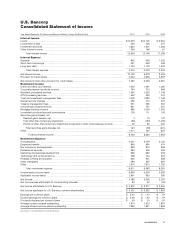US Bank 2011 Annual Report Download - page 82
Download and view the complete annual report
Please find page 82 of the 2011 US Bank annual report below. You can navigate through the pages in the report by either clicking on the pages listed below, or by using the keyword search tool below to find specific information within the annual report.Trust and Investment Management Fees Trust and
investment management fees are recognized over the period in
which services are performed and are based on a percentage of
the fair value of the assets under management or
administration, fixed based on account type, or transaction-
based fees.
Commercial Products Revenue Commercial products
revenue primarily includes revenue related to ancillary services
provided to Wholesale Banking and Commercial Real Estate
customers including standby letter of credit fees, non-yield
related loan fees, syndication and other capital markets
related revenue, non-yield related leasing revenue and foreign
exchange fees. These fees are recognized as earned or as
transactions occur and services are provided.
Mortgage Banking Revenue Mortgage banking revenue
includes revenue derived from mortgages originated and
subsequently sold, generally with servicing retained. The
primary components include: gains and losses on mortgage
sales; servicing revenue, including losses related to the
repurchase of previously-sold loans; changes in fair value for
mortgage loans originated with the intent to sell and measured
at fair value under the fair value option; changes in the fair
value of mortgage servicing rights (“MSRs”); and the impact
of risk management activities associated with the mortgage
origination pipeline, funded loans and MSRs. Net Interest
income from mortgage loans is recorded in interest income.
Refer to Other Significant Policies in Note 1, as well as Note
10 and Note 21 for a further discussion of MSRs.
Deposit Service Charges Service charges on deposit accounts
are primarily monthly fees based on minimum balances or
transaction-based fees. These fees are recognized as earned or
as transactions occur and services are provided.
Other Significant Policies
Intangible Assets The price paid over the net fair value of
acquired businesses (“goodwill”) is not amortized. Other
intangible assets are amortized over their estimated useful
lives, using straight-line and accelerated methods. The
recoverability of goodwill and other intangible assets is
evaluated annually, at a minimum, or on an interim basis if
events or circumstances indicate a possible inability to realize
the carrying amount. The evaluation includes assessing the
estimated fair value of the intangible asset based on market
prices for similar assets, where available, and the present value
of the estimated future cash flows associated with the
intangible asset.
Income Taxes Deferred taxes are recorded to reflect the tax
consequences on future years of differences between the tax
basis of assets and liabilities and their financial reporting
carrying amounts.
Mortgage Servicing Rights MSRs are capitalized as separate
assets when loans are sold and servicing is retained or if they
are purchased from others. MSRs are recorded at fair value.
The Company determines the fair value by estimating the
present value of the asset’s future cash flows utilizing market-
based prepayment rates, discount rates, and other
assumptions validated through comparison to trade
information, industry surveys and independent third party
valuations. Changes in the fair value of MSRs are recorded in
earnings during the period in which they occur. Risks inherent
in the MSRs valuation include higher than expected
prepayment rates and/or delayed receipt of cash flows. The
Company utilizes interest rate swaps, futures, to-be-
announced securities (“TBAs”) and options to mitigate MSR
valuation risk.
Pensions For purposes of its pension plans, the Company
utilizes its fiscal year-end as the measurement date. At the
measurement date, plan assets are determined based on fair
value, generally representing observable market prices or the
net asset value provided by the plans’ administrator. The
actuarial cost method used to compute the pension liabilities
and related expense is the projected unit credit method. The
projected benefit obligation is principally determined based on
the present value of projected benefit distributions at an
assumed discount rate. The discount rate utilized is based on
the investment yield of high quality corporate bonds available
in the marketplace with maturities equal to projected cash
flows of future benefit payments as of the measurement date.
Periodic pension expense (or income) includes service costs,
interest costs based on the assumed discount rate, the
expected return on plan assets based on an actuarially derived
market-related value and amortization of actuarial gains and
losses. Pension accounting reflects the long-term nature of
benefit obligations and the investment horizon of plan assets,
and can have the effect of reducing earnings volatility related
to short-term changes in interest rates and market valuations.
Actuarial gains and losses include the impact of plan
amendments and various unrecognized gains and losses which
are deferred and amortized over the future service periods of
active employees. The market-related value utilized to
determine the expected return on plan assets is based on fair
value adjusted for the difference between expected returns and
actual performance of plan assets. The unrealized difference
between actual experience and expected returns is included in
expense over a period of approximately twelve-years. The
overfunded or underfunded status of the plans is recorded as
an asset or liability on the consolidated balance sheet, with
changes in that status recognized through other
comprehensive income (loss).
Premises and Equipment Premises and equipment are stated
at cost less accumulated depreciation and depreciated
primarily on a straight-line basis over the estimated life of the
80 U.S. BANCORP
























